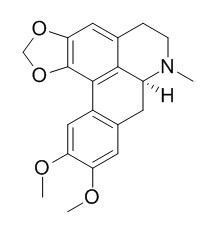Dicentrine
Dicentrine, a selective α(1)-adrenoceptor antagonist with potent antiarrhythmic and antihypertensive activities, it also has antinociception in different models of chemical pain. Dicentrine induces DNA lesions to arrest cell cycle. Callus and cell suspension cultures of S. venosa can produce high levels of Dicentrine as an alternative source of plant materials.
Inquire / Order:
manager@chemfaces.com
Technical Inquiries:
service@chemfaces.com
Tel:
+86-27-84237783
Fax:
+86-27-84254680
Address:
1 Building, No. 83, CheCheng Rd., Wuhan Economic and Technological Development Zone, Wuhan, Hubei 430056, PRC
Providing storage is as stated on the product vial and the vial is kept tightly sealed, the product can be stored for up to
24 months(2-8C).
Wherever possible, you should prepare and use solutions on the same day. However, if you need to make up stock solutions in advance, we recommend that you store the solution as aliquots in tightly sealed vials at -20C. Generally, these will be useable for up to two weeks. Before use, and prior to opening the vial we recommend that you allow your product to equilibrate to room temperature for at least 1 hour.
Need more advice on solubility, usage and handling? Please email to: service@chemfaces.com
The packaging of the product may have turned upside down during transportation, resulting in the natural compounds adhering to the neck or cap of the vial. take the vial out of its packaging and gently shake to let the compounds fall to the bottom of the vial. for liquid products, centrifuge at 200-500 RPM to gather the liquid at the bottom of the vial. try to avoid loss or contamination during handling.
Natural Product Communications2020, doi: 10.1177.
Int. J of Herbal Med.2023, 11(1): 06-14
J Nat Med.2020, 74(3):550-560.
TCI CO.2019, US20190151281A1
J Sep Sci.2020, 43(22):4148-4161.
J Ethnopharmacol.2017, 206:73-77
Comp. & Mathematical Methods in Med.2022, 5475559.
Food Chem.2024, 456:140044.
Cell Rep.2022, 39(1):110643.
Cell Death Dis.2019, 10(12):882
Related and Featured Products
Nat Prod Commun. 2013 Apr;8(4):443-5.
Dicentrine production in callus and cell suspension cultures of Stephania venosa.[Pubmed:
23738448]
METHODS AND RESULTS:
The highest Dicentrine content (19.5 +/- 0.3 mg/g dry weight) from callus culture of Stephania venosa was achieved from stem segments cultured on MS medium supplemented with TDZ 0.5 mg/L and NAA 1.0 mg/L. Cell suspension cultures were established from callus cultured on MS liquid medium with the same plant growth regulators. Dicentrine production from S. venosa cell suspension cultures was obtained in the range of 15-26 mg/g dry weight. Elicitation in cell suspension cultures by chitosan (50 mg/L) and salicylic acid (2 mg/L) for 6 days significantly increased Dicentrine content.
CONCLUSIONS:
Our findings indicate that callus and cell suspension cultures of S. venosa can produce high levels of Dicentrine as an alternative source of plant materials.
Planta Med. 2012 Sep;78(14):1543-8. Epub 2012 Jul 16.
Antinociceptive effects of a chloroform extract and the alkaloid dicentrine isolated from fruits of Ocotea puberula.[Pubmed:
22815198]
The present work describes the chemical characterization of a chloroform fraction (CF) obtained from an extract of Ocotea puberula (Lauraceae) fruits, and preliminary antinociceptive analysis of CF and the alkaloid Dicentrine, isolated from this fraction.
METHODS AND RESULTS:
CF (30-300 mg/kg, p. o.) caused dose-related inhibition of abdominal constrictions caused by acetic acid and also inhibited both phases of formalin-induced nociception. Furthermore, Dicentrine (30-300 mg/kg, p. o.) produced dose-related inhibition of acetic acid-induced pain without causing changes in the motor performance of mice.
CONCLUSIONS:
The results show, for the first time, that CF from Ocotea puberula fruits produced marked antinociception in different models of chemical pain, and this effect appears to be, at least in part, due to the presence of Dicentrine. The mechanism by which CF and the alkaloid produced antinociception still remains unclear, but the adenosinergic or opioid system seems unlikely to be involved in this action.
Drug Metab Dispos. 2010 Oct;38(10):1714-22.
Metabolism of dicentrine: identification of the phase I and phase II metabolites in miniature pig urine.[Pubmed:
20622045]
METHODS AND RESULTS:
The metabolic profile of Dicentrine, a selective α(1)-adrenoceptor antagonist with potent antiarrhythmic and antihypertensive activities, in miniature pig urine via oral administration was investigated for the first time. The urine, collected after a single oral administration of Dicentrine, was pretreated using solvent extraction and column chromatographic methods to identify the metabolites containing fractions.
CONCLUSIONS:
The phase I metabolic transformations of Dicentrine were found to be N-demethylation, N-oxidation, O-demethylation (9,10-OMe), O,O-demethylenation (1-OCH(2)O-2), and hydroxylation at the benzylic (C-4) and the aromatic (C-3) positions, whereas those for the phase II were O-glucuronidation and O-glucosylation of the phenolic group of the phase I metabolites.
Biochem Pharmacol. 2010 Apr 15;79(8):1092-9.
Inhibition of epidermal growth factor receptor over-expressing cancer cells by the aphorphine-type isoquinoline alkaloid, dicentrine.[Pubmed:
20005213]
The extraordinary relevance of EGFR in tumour biology makes it an exquisite molecular target for tumour therapy. Despite considerable success with these EGFR tyrosine kinase inhibitors in cancer therapy, resistance against these chemical compounds develops owing to the selection of point-mutated variants of EGFR.
METHODS AND RESULTS:
Therefore, there is an urgent need for the identification of novel EGFR tyrosine kinase inhibitors for treating tumours with such EGFR mutants. We found a preferential cytotoxicity of Dicentrine towards U87MG.DeltaEGFR-transduced with a constitutively deletion-activated EGFR expression vector as compared to non-transduced wild-type U87MG cells. As determined by microarray-based mRNA expression profiling, this preferential cytotoxicity was accompanied with an activation of BRCA1-mediated DNA damage response, p53 signalling, G1/S and G2/M cell cycle regulation, and aryl hydrocarbon receptor pathways.
CONCLUSIONS:
The activation of these signalling routes might be explained by the fact that Dicentrine intercalates DNA and induces DNA strand break by inhibition of DNA topoisomerases. The cell cycle might be arrested by Dicentrine-induced DNA lesions.



